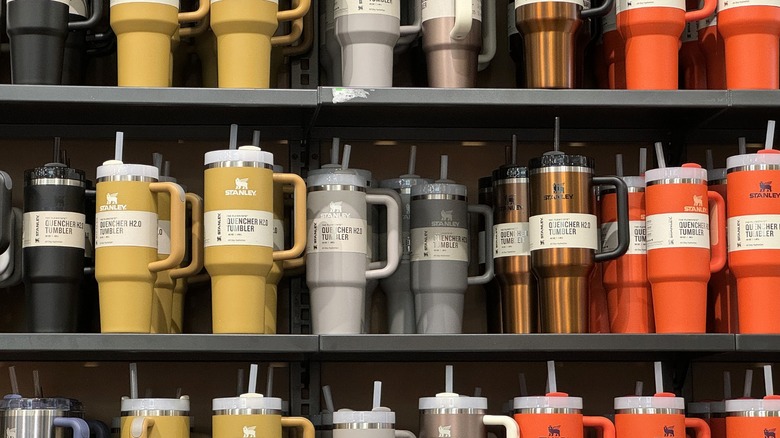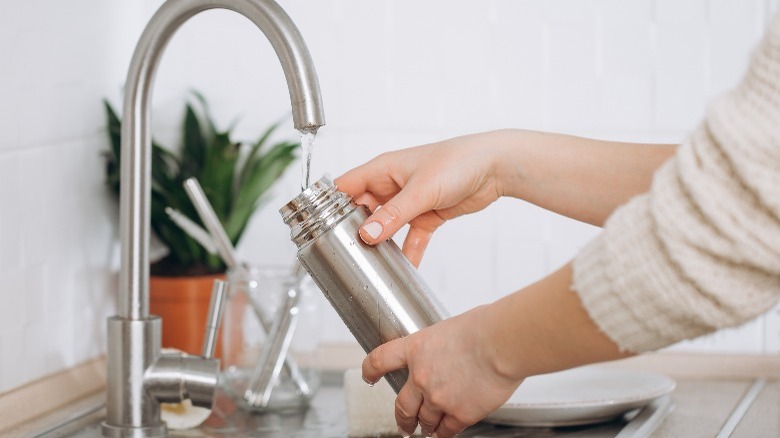The Unexpected Part Of Your Stanley Cup That's A Hidden Breeding Ground For Mold
Modern water bottles now offer more than just hydration; they enhance your overall drinking experience too. Case in point: The Stanley Quencher 2.0 rocks a super cool Flowstate lid, which lets you drink straight from the big opening, sip through a straw, and seal it tight to stop any spills. However, the tumbler lid's three-part design — the main lid and a two-part silicone piece (the one you rotate) — have nooks and crannies where moisture and leftover bits (like pulp from your morning smoothie or powder from your protein shake) hide out and create the perfect breeding ground for mold.
Mold in the nooks and crannies of complex water bottle lids, like the Stanley Quencher 2.0's Flowstate lid, isn't a new problem. But this issue surprised several Stanley cup users, including TikToker Skylar, aka @skysayingthings, who shared their unpleasant discovery with followers. Since Stanley cups are dishwasher safe, some people just toss the entire lid in and are unaware that you can actually detach the rotating part. This oversight means those hard-to-reach spots don't get thoroughly cleaned, leading to mold formation — a problem that only becomes apparent when you disassemble it.
How to thoroughly clean your Stanley cup
Consumer Reports contacted Stanley to ask the company how to clean the water bottle properly. Stanley's senior hydration product manager, Kyle Casteel, explained, "The easiest way to clean your Stanley is to toss it in the dishwasher, but first, check the bottom of your Stanley to make sure it reads 'dishwasher safe.' The majority of our products, including the Quencher, are dishwasher-friendly." However, this isn't the end of it.
Casteel further stressed that you should disassemble all of its parts, including the straw, the lid, and the tab on the lid (the silicone part). Once disassembled, simply toss them all into the dishwasher. If you'd prefer to hand wash your bottle, use a sponge, a mild detergent, and warm water to clean the interior, exterior, and all the little pieces. Then, use a sponge to clean the exterior of the straw and a narrow brush to scrub its interior.
You can also check out Stanley's TikTok video on how to hand wash their tumblers. You may need a deeper clean if you're using your bottle for beverages other than water, though. As Casteel instructed, "Use a mixture of one part baking soda and one part warm water, and soak for up to an hour. Then clean with mild detergent once the solution is rinsed out." Notably, this will also remove stinky odors from your reusable water bottle.
How often should you clean your tumbler?
So, how often do you need to clean your reusable water bottle? You should at least rinse your Stanley cup and straw — or any other water bottle you're regularly using, for that matter – on a daily basis. Ideally, though, you should wash it after each use. TikTok user @nicolekramer shared a video showing mold in her Stanley cup after just a weekend of use.
She highlighted in her caption how easy it is to lose track of the last cleaning, especially with constant use. To prevent this, make it a habit to thoroughly rinse and wash your Stanley cup each time you empty and refill it. Regular rinsing and washing should be done even if you only use it for water, but more so if you store other beverages, like smoothies, juices, and sodas.
A 2017 study published in Food Protection Trends pointed out that water bottles that contain beverages other than water were more contaminated than those that only housed water. This could be because of the sugar content and food residues that are harder to remove but suffice it to say, regardless of what you keep in your Stanley cup, you should ensure it's getting thoroughly cleaned regularly to prevent mold.

